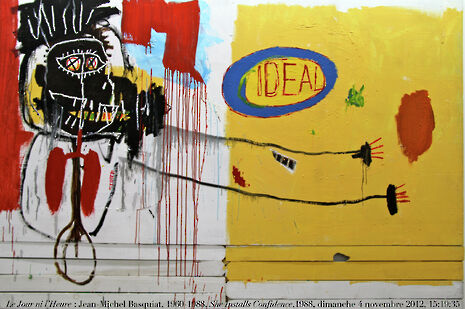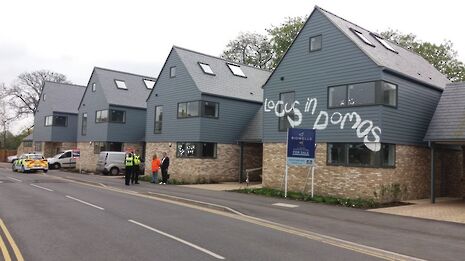Street art, subversion and urban space
Against the backdrop of legal graffiti walls, Emma Slater probes the history of the street art movement back to its roots in visual subversion

Earlier this year a group of street artists began a conversation with Bristol county council, asking for approximately 50 walls across the city to become legal spaces onto which they might be permitted to paint. The conversation comes in response to Bristol mayor Marvin Rees’s Clean Streets initiative in 2016, which aims to make Bristol visibly cleaner by 2020.
Such discussions are a long way from street art’s 1980s roots, where graffiti artists such as Jean-Michel Basquiat risked not only prosecution but police brutality every time they practised their work. Michael Stewart’s murder at the hands of New York police officers as he attempted to spray-paint a subway station wall is just one example of the threat artists faced at this time, and the extent to which criminal damage laws were not only enforced but grossly abused and often racially motivated.
Of course, police brutality remains an issue and street artists still run the risk of prosecution, but street art (in the UK at least) has significantly progressed from this oppressive regime. Street art thrives in Bristol, London and urban spaces all over Britain, and questions of legality seem to be no longer the most pressing issue. Not only are we far from the violence of Basquiat’s oppressive New York, but it seems that we’ve also lost touch with street art’s visually subversive roots as the medium becomes increasingly dominated by one name.
“Street art should aspire to be more than just a statement about itself, more than just an expression of one artist’s dark world view.”
Banksy’s work lacks this subversive propulsion. His/her political witticisms have little depth, relying mostly on banal juxtapositions that are highlighted by a crude and patronising use of colour for emphasis. Banksy, who works almost exclusively by night and has not revealed his/her true identity, seems to fetishize the illicit role that street art played in the 80s – whilst ignoring what actually made it exciting.
Basquiat’s nightmarish visions, SAMO’s poetic and political scrawlings and Keith Haring’s kinetic vibrant murals – to name just a few – all altered the urban environment, transforming it visually through art and the written word. They changed the way New Yorkers looked and interacted with their city.
Admittedly, Banksy has, in a way, changed the way we look and hear about Bristol. There are endless Banksy walking tours around the city, and it’s not rare to hear ‘Bristol: the home of Banksy’. His/her work is on so many gift cards, so many Facebook cover photos – but it can’t avoid coming across like merely a token for the city. Banksy’s work is now so familiar, and its imagery so basic, that it feels ironically like seeing the very commercialized logos that Banksy originally parodied. The artwork does nothing but advertise itself anymore.

Street art should aspire to be more than just a statement about itself, more than just an expression of one artist’s dark world view. And there are numerous street artists whose work gives much more.
London-based Stik’s work, for instance, portrays the lives of those living inside the buildings he paints on. ‘Big Mother’, which he painted on Charles Hocking house in 2014, was a 125 ft high mural of a mother and child standing homeless on a council flat block in West London as luxury apartments are constructed around them. As ‘Big Mother’ does so well, Stik’s work often addresses socio-political concerns whilst simultaneously transforming the landscape in which they exist. He answers his political agenda with action, using street art not just as a demonstration of the numerous ills of the modern urban environment, but as an antidote. With his bright block colours, Stik follows in the footsteps of Haring’s NYC subway murals, and the work of both are testament to street art’s ability to transform urban space for the community.
Stik’s ‘commission’ policy is perhaps something we can learn from. In a Guardian interview, he claims to ask members of the community for permission before he begins a work, looking for “implied indifference, at least.” Legality is for him not the issue: it is community approval, or at least ‘implied indifference’, that is of most importance.
Street art has changed from its NYC 80s roots: as graffiti becomes more popular, street artists are moving out of the shadows and working within the community. As the form progresses into something actively contributing to urban renewal, as well as commenting on it, the most important thing for street art is to remember its visually subversive roots. Good street art both comforts and confronts us – and we see it every day. Whether or not the council sanctions these street artists is thus a subsidiary issue: transforming urban space is a subversive act in itself, be it legal or illegal
 News / Local business in trademark battle with Uni over use of ‘Cambridge’17 January 2026
News / Local business in trademark battle with Uni over use of ‘Cambridge’17 January 2026 News / Cambridge bus strikes continue into new year16 January 2026
News / Cambridge bus strikes continue into new year16 January 2026 Comment / Fine, you’re more stressed than I am – you win?18 January 2026
Comment / Fine, you’re more stressed than I am – you win?18 January 2026 News / News in Brief: cosmic connections, celebrity chefs, and ice-cold competition18 January 2026
News / News in Brief: cosmic connections, celebrity chefs, and ice-cold competition18 January 2026 Film & TV / Anticipating Christopher Nolan’s The Odyssey17 January 2026
Film & TV / Anticipating Christopher Nolan’s The Odyssey17 January 2026










